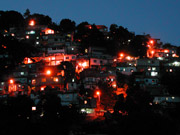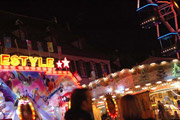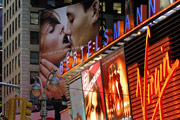CITY AND LIGHT
Phenomenology of the lit-up landscape
Coordinator: Francesca Zanella. Curators: Ilaria Bignotti, Davide Chiastra, Marco Scotti, Francesca Zanella. |
| C.F. Corini, Rocinha, 2005 |
|
How wrote Hans Sedlmayr (La luce nelle sue manifestazioni artistiche, 1960) the relationship between work of art and light could be aware or unaware, and so programmed. If we talk about light we must think of light from a natural source (sun and moon) as much as light from an artificial source (fire, optic fiber). In the relation with the work of art the variables are the matter, the surface, the colour, and all these elements belongs either to the domain of the unconscious interaction than to the one of a sought relation; to all these elements we must add, peculiar of a build up and programmed relation, the symbolic meaning and of the light, its metaphoric representation. If we tackle precisely the ambit of architecture, goes on Sedlmayr, the analysis of the relationships with the light should be in relation with the external space as in relation with the interiors.
It’s possible to record, today, a renewed interest towards this theme, in some cases revived in the same terms asserted by Sedlmayr, that associated to the seculariztion process of modern society the progressive lost of a symbolic and sacred value of the light inside the project; some time otherwise the light is employed as a signal that unveils, that makes understandable or that creates the space.
How can we deal with the theme of the relationship between city and light, and which results could we obtain?
 |
| C.F. Corini, Basel, 2005 |
|
The history of the relationship between urban space and light is certainly linked to the history of surveilance and safeguard methods and, by the other side, of representations of power and reseaches of the element to amaze, through the triumphs and the transmigration of the scenic action from the theatres to the streets and squares. Within the industrial city this elements partly change: the role of instrument of oveseeing and security goes alongside, gaining more and more strenght, the iconic and semantic component, the light is a tool that carries on and reinforces communication and at the same time is a message, a role inside of which the interlacement of the project component and the random element is very strong, making any analysis problematic.
The history of the relationship between light, architecture and the city can’t leave out some moments, when the light is intentionally substance of the project (from the cosmological monuments, the gothic cathedral, as told by Grabar, till the baroque project to reaech finally the illuministic culture, inside of which the light becomes a metaphor for the reason).
In the urban culture
Nella cultura urbana dell’età dell’industrializzazione la luce è fonte di shock (Benjamin) e quale strumento inconsapevole contribuisce alla conoscenza delle nuove strutture che trasformano il paesaggio e diventa una delle metafore della modernità:
*The factory of the industrial revolution is perceived particularly during
the night for the reddish glares that lets out changing the night landscape.
*The natural light floods the space of the new cathedrals of the industrial city towards the iron and cast iron structures.
*The blinding light of the arch lamp, icon of the modern for the futurists, but also the projector light that lights up the new show places.
*The spreading of electric lighting on the streets and inside the houses tranforms the urban space and the domestic landscape.
*The coloured neon sign, an icon of the pop and optical culture, as a popular instrument that defines the new urban space
*Lighted up screens as broadcaster of images double the urban landscape, of the day and of the night, interacting with architecture.
This of journey of the unconscious interaction is sided, and sometimes crossed, the journey of the light project:
*The rational planning take inside the project standards the analysis of the helio-thermic orientation, as a process to laicize the sun cult, in the name of the myth of the hygiene and health body.
*The Fifites: natural light returns to be used as an instrument to create the modelling of the holy places (civil and religious ones) starting from a reflection on the archetypes and on the daily rituals, collective and private ones.
*Psychedelic lights are used as a tool to create artificial spaces.
*The lighting of the places of the power and of the hystorical monuments contributes to the “monumentalization” of the city.
*Lighting architectures, designed to have a double life, by the day and by the night.
*The myth of the darkness returns to re-take to an awareness of the relation between the body and the ambient and space.
*The night and the light of the stars are re-discovered in the name of ecologist instances
 |
| C.F. Corini, Times Square, New York, 2007 |
|
The question is if, and in which terms, the distinction between natural and artificial light is perceived in the western city, and if, and in which terms, the artificial lights continue to have the same effect of visual shock or unveiling; which is the role, and which significance could light projects have in the western civilization.
The first phase of the research, which will take to the definition of the future exhibition structure that will be based upon the individuation of some cases to study, of micro-stories and critical diachronic journeys, previews to exhamine the enquiry methodolgies about the contemporary city, the reception and tell modalities and the approaches to urban planning to understand which role has the light, what are the symbolic and ‘functional’ significances, which relationships between lighted up places and places designed with light, between light places and shadow places.